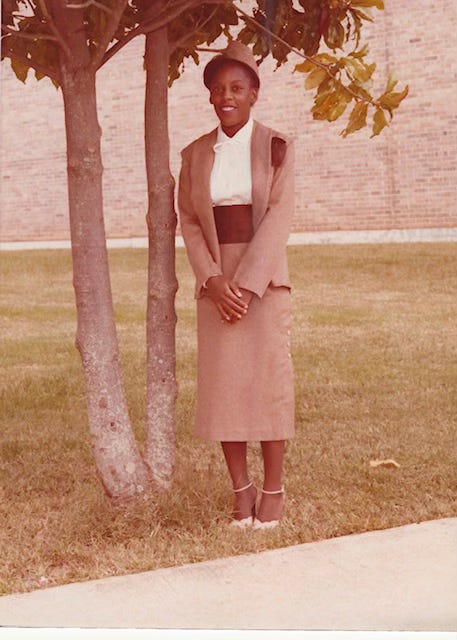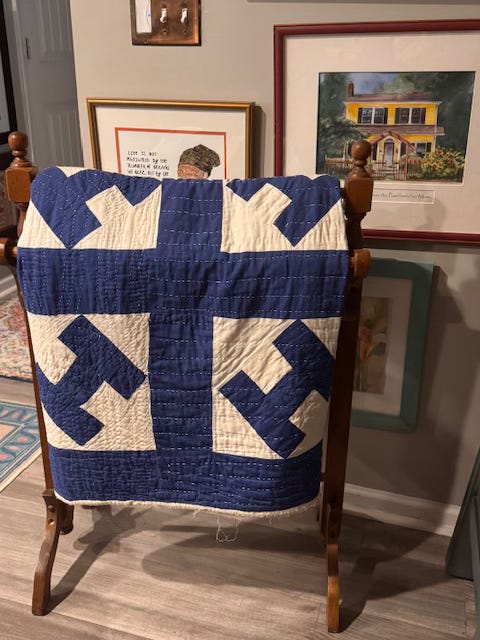Photo Credit: Will Crooks.
I don’t sew—not really. But I do love quilts and clothes. I love textiles and mixed prints. It is who I am. It is in the way I walk, and the way I carry myself. It is in my ways, and in my writing.
I got this love of fabric and design from my Mama. She, in turn, got it from her Mama which she in turn got from her Mama. We love to dress ourselves and our homes. It is a way we take up space in the world. A world that did not always see or welcome Black women. With what we wore, we warm entry ways before a word was ever spoken.
I come from a long line of quilters and seamstresses.
Of course, I tried my hand at sewing—I even earned an A in Mrs. Epp’s Home Economics class at Woodmont High School. But truth be told, I had my own stellar personal seamstress at home: Mama. I felt no need to sew. I was the model. I was a walking advertisement for Mama’s craft. She made my clothes for me and was proud to wear them. When I was a child I loved how I stood out in my colorful rompers, jumpers, and pantsuits.
Mama, Jeanette Redmond with a quilt made by her Mother, Katie Latimore.
Mama didn’t just stitch garments—she stitched power and presence into every seam. Her Mother taught her to sew on this foot-pedaled Singer sewing Machine.
I wasn’t too fond of the process of going to the fabric store (all those notions and decisions felt endless), but I loved the final product. Mama also taught me about her dedication to her craft which in turned taught me to love my own passions with dedication and eye on detail.
Mama made me this brown tweed suit with a pencil skirt and a matching folding Air Force hat for the homecoming court which I designed. It had a dark brown satin cummerbund. I was the first girl in my high school to wear one. I’d seen the cummerbund in a New York fashion magazine, and my Mama brought it to life.
On one occasion she also crafted a sky-blue silk skirt suit with a pillbox hat for my student government Vice-Presidential speech. I won. But my favorite outfit of all time was a gold lamé two-piece—pants and top—with drawstrings at the pant legs and sleeves, inspired by the Solid Gold Dancers. I loved this dance show on TV. I wore this one of a kind outfit to the Ruritan Club for a school dance and went straight to the center of the empty dance floor and got the party started. I was my own Studio 54—sans drugs—in Moonville, South Carolina. I so wish I had a picture of that moment. That outfit shimmered. I shimmered.
I now gather, not with stitches, but with memory with stories. As a poet, I believe I do with story and lineage what my foremothers did with fabric.
My foremothers pieced together bits and ends to make the essentials for survival—not just to keep warm, but to express beauty and belonging. They followed their own patterns and designs, whether or not anyone outside our world recognized the art in their craft. We always knew its value, meaning, and beauty.
These hands that sewed are the ones that held us together.
I have two quilts passed down to me—stitched by my grandma and great-grandma. They are two of my most prized possessions. In their stitches, I read what they could not write. There are no known pictures of my great-grandmother Rachel, but her quilt is a stand-in.
Quilt made by Rachel Cunningham.
It is all I have of her besides blood memory and family lore. So, I write for her and for the others who speak to me through the ethers. My writing is a way to honor them—and also a way for me to speak back to them.
What My Foremothers Left Me I see many hands–– hands that could barely write–– hands that could not write at all, but insistent in their intelligence by tending to people and plots. From bits and ends. they could work the cloth. Sow and sew. It could be land, It was land. I’ll take it for a coat of arms though. The one we never had to keep us warm–– to hold us down with history. I’ll wear the bold red and white patterns. There’s a story of love and blood woven into the fabric. There’s aching in the acreage, a love letter. “Study it,” they say. I read, Dear Future, One. Take this heirloom here. Read it for signs that this way we came. We were here. Though they tried to erase us. Let this plot of postage stamp squares hold you down. Keep you. We know that It’s not enough granddaughter, poet but see each stitch as a word: Hobbled lettering. See sentences upon sentences in which we were sentenced. Each piece, a patched world. We give you this: a page, a map. Garden. Flowers. See us: Women blooming. There, then. Here, now. Don’t measure us by what was taken, but what we gave. What we grew into you: warmth and a way even now.
Though I don't sew today, my appreciation for design—on the body and in the home—runs deep. These quilts that my mother gave me, stitched by my grandmother and great-grandmother, are living legacies. Love made visible. Warmth made permanent. This love of handmade beauty, passed down through generations, is what led me to create a new poetic form: the Afro-Carolinian Quilt Stitch. It is how I stitch now—through poems. With memory, rhythm, wisdom, and praise. I created a new poem form. It is the Afro-Carolinian Quilt Stitch. Created on May 26, 2025
The Afro-Carolinian Quilt Stitch is an eight-line tribute poem—an anthem, a patch of hope, a square of resilience. Stitched from the scraps of survival and spirit, it is inspired by the Black Southern quilting tradition.
This form gathers fragments—snatches—of ancestral wisdom and strength,
offering warmth, witness, and uplift.
It is a make-do poem form. Each poem should pull from what gives you hope in times of sorrow, what lifts you when the world feels heavy. Piece your poem together using at least four of the following elements, Parts of these not necessarily in whole. It is meant to be snatches or fragments of:
An African proverb
A Southern saying or familial saying/adage
A Gospel or spiritual lyric
End the poem with a blessing or benediction
The Afro-Carolinian Quilt Stitch draws deeply from the quilting tradition of my maternal line. My foremothers quilted with what they had—some bought fabrics, but mostly scraps: old sheets, clothes, curtains, and sack cloth. They turned castoffs into beauty. I had my own version of Gee’s Bend. So do many African Americans in the South. I am particularly interested in the Upstate of South Carolina where my lineage ended up.
Each quilt was a visual, celebratory remembrance—stitched in community at quilting bees or sewn in solitude. They quilted to warm our bodies and remind us we were loved. Their hands turned scraps into comfort, pattern into praise, and labor into legacy.
This poem form honors their memory and extends their stitching into the realm of language. The form is not rigid but reverent. Like a quilt sewn by many hands, it is meant to buffer, to keep, to carry. Each line is a stitch from memory to future, from shadow to light.
Afro-Carolinian Quilt Stitch Example #1 Sew and Sow Give Mama her flowers while she’s living, even though she sings: Every duck praises its own pond. I believe you praise your pond only if it raises you to higher more tender heights. Mama sewed and sowed into me, so this too is how I tend to my flock: a knowing look, inspiration, a jewel of affirmation. Sometimes I wanted to get there fast, so I went alone, but really, I was always carried by the many who made me into this body of water. There’s a tributary flowing from my pen: This little light of mine, I’m gonna let it shine. May you praise your own pond if love be there and may you be praised in return. May you gather this beauty. May you in turn touch backs and bid those backs to sprout wings.
I hope the integrity of the form comes through on substack when it is published. It should be in eight lines divided, into four couplets.
This form was created and sewn into being with gratitude for my ancestors—named and unnamed, known and unknown—who walked before us with vision, song, and steady hands.
Please try your hand at writing an Afro-Carolinian Quilt Stitch. Let me know how it goes.
Please send me your Quilt Stitch poem, I would love to read it.









I wish you had a photo of you in that gold pants suit, too, but no need, for me. I can see you, spinning out there.
My grandmother sewed on a sewing machine much like the one pictured. I have written several poems about her and what I learned from her sewing. I just might try one in your new form. Very inspiring!
My grandfather sold Nabisco cookies from his horse drawn carriage in Bridgeport, Connecticut before the area had changed from farmland to a city.. My grandmother did everything else the family needed. When my aunt went to college because my grandfather was a very good cookie salesman, my grandmother would stand in front of the elegant ladies shops on Newbury Street, sketching the beautiful clothes she created for her eldest child. Cookie sales did not include the expense of nice clothes for my grandfather's wife or children. I have seen pictures of my favorite aunt when she went to dances with her best beau who became my favorite uncle. I loved the story behind the pictures. My grandmother was always my hero and these images just lent more truth to how remarkable she was.